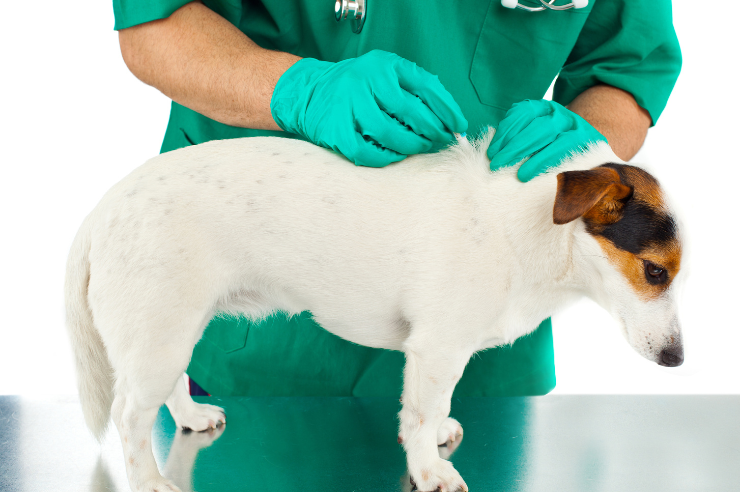How to Prevent Ticks
The information in this blog post was provided by experts in The Vet Connection in April 2024 who operate the An Post Insurance Pet Insurance 24-hour Vet helpline.
Ticks can be a hassle all year round, but they tend to come out more when the weather is warmer, usually between March and November. During these months, it's crucial to make sure your furry friend is protected against ticks. You can do this with a spot-on liquid applied to the back of their neck, a tablet, or a collar. It's a good idea to talk to your vet about which option is best for your pet before you start treatment.

What are ticks?
Ticks belong to the same family as spiders, ranging from 1mm to 1cm in length with eight legs. They typically sport shades of grey or brown and have tiny pin-sized heads that they bury into your pet's skin to feed from their blood. Ticks cannot jump; they crawl or fall onto your pet when they walk through long grass or an area that has lots of wildlife.
Why ticks worry us?
Ticks are bloodsuckers, and they're not just annoying — they're also carriers of diseases. They're experts at passing on illnesses from one animal to another, including us humans. With diseases like Lyme disease on the table, it's crucial to keep an eye out for ticks and take preventive measures.
How to remove ticks
If you spot a tick on your pet, it's essential to remove it as soon as possible. Ticks often gravitate toward areas like the head, ears and neck, but they can attach themselves anywhere on the body.
Here's how to safely remove a tick
- Ideally, wear rubber or plastic gloves to protect yourself.
- If you're using fine-tipped tweezers, grasp the tick as close to your pet's skin as possible and pull upward with steady, even pressure. Avoid twisting or jerking the tick to prevent its mouthparts from getting stuck or from regurgitating infected fluids.
- If you have a tick hook remover tool, slide the two prongs on either side of the tick's body until it's secure. Gently turn the tool either clockwise or anticlockwise, and the tick should detach after a few rotations.

What not to do when removing ticks
- Do not grasp the tick’s body as this can cause blood to be pushed back into your pet and increase their chances of disease.
- Avoid handling the tick with your bare hands, as infective agents can enter through breaks in the skin or mucous membranes.
- Absolutely avoid using petroleum jelly, liquid solutions or attempting to freeze/burn the tick, as this could prompt it to regurgitate its stomach contents, increasing the risk of infection.
After removing the tick, clean the bite site with saline solution and wash your hands thoroughly with soap and water.
Concerned about your pet or a possible tick infection? An Post Insurance Pet Insurance includes a 24-hour helpline, which is operated by The Vet Connection 365 days a year and gives policy holders access to their national network of Royal College of Veterinary Surgeons-registered veterinary nurses. Policy holders can call one of their registered veterinary nurses on 01 913 1067 for advice at any time.
If you’re in the market for Pet Insurance, why not get a quote today by clicking on the link below.
Explore some of our other articles to learn more about being the best pet owner you can be. Read our tips on how to be a responsible dog owner, treating an upset tummy and puppy proofing your home. Also learn how your pets can benefit your mental health
An Post Insurance Pet Insurance is arranged and administered by Cover-More Blue Insurance Services Limited who is regulated by the Central Bank of Ireland and underwritten by H.W. Kaufman Group Europe BV, trading as Cranbrook, on behalf of the insurer, Sava Insurance Company.
All the information on this blog is published in good faith and for general information purposes only. While An Post Insurance makes every effort to ensure that the information appearing on this blog is accurate and complete, it does not make any warranties about the completeness, reliability or accuracy of this information, whether express or implied, including but not limited to implied warranties of merchantability, fitness for a particular purpose or non-infringement. Any action you take upon the information you find on this blog is strictly at your own risk. An Post Insurance will not be liable for any direct, indirect or consequential losses and/or damages in connection with the use of, or action taken in reliance on information contained in our blog.
Through this website you are able to link to other websites which are not under the control of An Post Insurance. We have no control over the nature, content and availability of those sites and if you click on links to these websites you will be subject to the terms and conditions of those sites. The inclusion of any links does not necessarily imply a recommendation or endorse the views expressed within them.




















